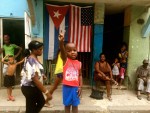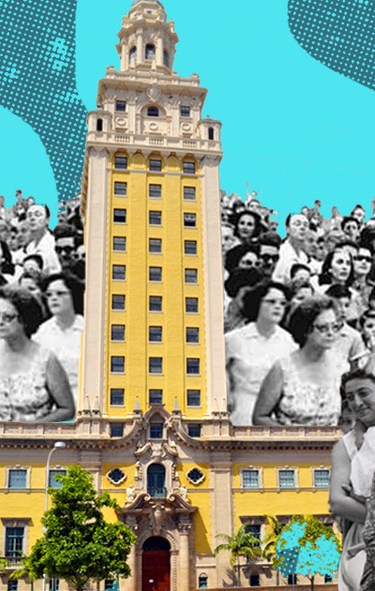It’s impossible to miss The Freedom Tower when driving along downtown Miami’s famous Biscayne Boulevard.
Though originally built in 1925 as the headquarters for Miami News, the 17-story Freedom Tower is best known as the “Ellis Island of the South” due to its role in helping Cubans who were seeking political asylum from Fidel Castro’s regime.
The Cuban Assistance Center at 600 Biscayne Boulevard offered nationally sanctioned relief to those refugees from 1962 to 1974, according to the National Park Service (NPS). That included basic medical and dental services, surplus foods, records on relatives already in the United States and relief aid for Cubans building a new life.
The National Historic Landmark is a nearly century-old building that lent its design from the Giralda Bell Tower of the Cathedral of Seville in Spain. Its 65,000-square-foot structure features beautiful oak main doors, wrought iron balconies and Corinthian capitals on the columns.

“The Freedom Tower stands as the single most identifiable building with the Cuban exile experience,” a National Historic Landmark nomination form reads in part. “The building stands as a physical manifestation of Cold War-era politics and the influence it exerted over national immigration policies developed to assist the steady stream of Cubans arriving in the United States during the period.”
In 1959, Castro assumed military and political power as prime minister of Cuba. Thousands of upper- and middle-class Cubans fled the country because of his policies, sparking a mass exodus to the U.S. This period also ushered in the Freedom Flights—considered the largest and longest resettlement program of Cuban refugees ever sponsored by the U.S. government, according to the Miami Herald. These flights brought Cubans to Miami twice each weekday from 1965 to 1973.
According to the NPS, the Cuban refugees who fled “left their belongings because they believed that they would be returning to Cuba after Castro’s surely imminent removal from power… they thought of themselves as exiles, not immigrants.”

Castro would go on to become president—a title he held for over three decades.
By 1957, Miami News decided to move to a new facility. The empty tower collected dust for the next five years until the U.S. government leased it in 1962 to assist Cuban refugees. Fluorescent lights were installed and rows of desks for government workers were brought in.
The Cuban Assistance Center, which was also commonly called the Cuban Refugee Center, operated out of the tower’s basement, lobby, mezzanine, third and fourth floors. The refugees first entered the grand lobby with its wooden coffered ceiling and chandeliers. They were then registered on the mezzanine level, according to Paul George, Ph.D., a Miami historian and history professor at Miami Dade College.

“They were treated very nicely by these federal officials as they registered, and then they were taken for maybe a medical checkup and/or a dental checkup,” George said in a video interview with the American Latino Heritage Fund Road Trip. “Then they were given what they might need. It might be government-issued cheese, it might be cash, it might be clothes, it might be shoes. They were also given some kind of a card that would give them a date [for] when they would come back again for further assistance.”
The building’s basement was essentially a medical dispensary with everything from physicians and dentists to a pharmacy. According to Fernando C. Mendigutia—former chief of the fiscal & personnel section of the Cuban Refugee Center—that was where refugees received health screenings.
Over the next 12 years, 650,000 refugees passed through the center’s doors, according to the Daily Commercial, and it was common to see a long line of Cubans on the sidewalk outside the center, waiting to be admitted.
“Some days it was impossible to close down activities until well along in the evening hours,” reads the caption on a black-and-white photo from 1966. The tower quickly earned the nickname of “El Refugio (The Refuge).”
Many of those who worked there were also Cuban.
Job opportunities became scarce due to the mass influx of workers in the Miami area and some refugees ended up resettling in other areas of the country.
After the U.S. government closed the center in 1974, ownership of the building changed hands several times through the years until the well-known Pedro Martin family bought it in 2004 and donated it to Miami Dade College the following year. The college later established the Museum of Art and Design at MDC inside the tower. The building also became the administrative home of different events like the Miami International Film Festival, according to a detailed timeline on the college’s website.
The Freedom Tower was officially designated a U.S. National Historic Landmark in 2008.
In 2014, Miami Dade College opened the Cuban Exile Experience & Cuban Diaspora Cultural Legacy Gallery—a historical component of the Museum of Art and Design which illustrates the struggles the Cuban exile community endured since Castro’s rise to power, as well as the things they have achieved in the U.S. despite them.
“It’s really really a beloved facility,” Natalia Crujeiras, executive director of cultural affairs at Miami Dade College, told Rise Miami News. “It’s important to the history of Miami but also the United States. And it represents that celebration of our history and our diversity.”




